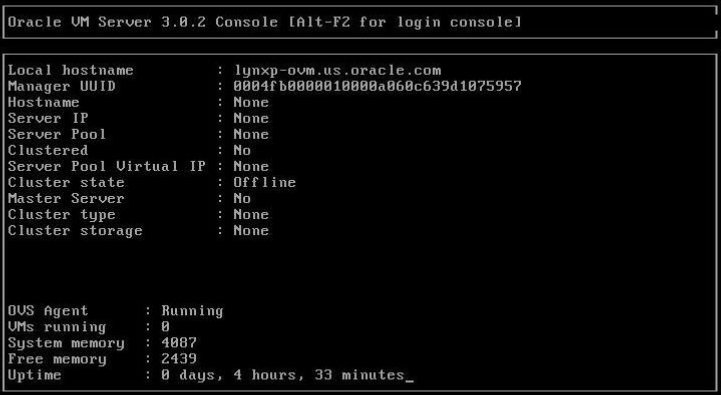Configure the Preinstalled Oracle VM Server
These instructions describe only how to configure preinstalled Oracle VM server on your server. Oracle VM also has other components, such as Oracle VM Manager, that must be installed or already operational to support the virtual machine environment.
- Log in to Oracle ILOM, either locally from a serial connection or remotely using an Ethernet connection.
-
Power on or reset the host, as follows:
-
To power on the host, use one of the following methods:
-
From the Oracle ILOM web interface, select System Information > Summary from the navigation panel. Then, click the Turn On button next to Power State in the Actions panel.
-
From the Oracle ILOM CLI, type the following command from the prompt:
-> start /System
When prompted, type y to confirm:
Are you sure you want to start /System (y/n)? y
Starting /System
-
-
To reset the server, use one of the following methods:
-
From the Oracle ILOM web interface, select Host Management > Power Control in the navigation panel. Then, select Reset from the Select Action list box and click Save.
-
From the Oracle ILOM CLI, type the following command from the prompt:
-> reset /System
When prompted, type y to confirm:
Are you sure you want to reset /System (y/n)? y
Performing hard reset on /System
-
The host boots.
-
-
Start the Remote Console.
- From the Oracle ILOM web interface, select Remote Control > Redirection in the navigation panel. Then, click the Launch Remote Console button.
-
From the Oracle ILOM CLI, type the
following command at the CLI prompt:
-> start /HOST/console
Are you sure you want to start /HOST/console (y/n)? y
Serial console started.
As the host boots, the GRUB menu appears. From the GRUB menu, you can choose whether you want to continue to direct the display to the serial port, or whether you want to direct the display to a device connected to the video port. For example:
GNU GRUB version 0.97 (613K lower / 2087424K upper memory) Oracle VM server-ovs (xen-4.0.0 2.6.32.21-41ovs) Oracle VM server-ovs serial console (xen-4.0.0 2.6.32.21-41ovs)
-
Use the up and down arrow keys to select a display option and press
Enter.
To pause at the GRUB menu, press any key other than Enter. Then select the option you want to use and press Enter to continue.
Note - If you do not select an option on the GRUB menu, after a delay, the GRUB menu is no longer available and the system continues with the output directed to the serial port.The menu offers two choices: one for normal booting, and one for serial-console enabled booting.
-
Use the up and down arrow keys to select which entry is highlighted. Press
Enter to boot the selected OS, 'e' to edit the commands before booting, or 'c'
for a command-line.
-
To display the default option, select the first option on the
list:
Oracle VM server-ovs (xen-4.0.0 2.6.32.32-41ovs)
-
To display output to the serial port, select the second option on the
list:
Oracle VM server-ovs serial console (xen-4.0.0 2.6.32.21-41ovs)
-
To display the default option, select the first option on the
list:
-
As the configuration process continues, the following screen appears. Scroll
down the screen and set and confirm the root password and the
Oracle VM Agent password.

Note - The prompts for the root and the Oracle VM Agent passwords are only displayed the first time you boot the Oracle VM server. -
Follow the prompts to select the onboard network interface controller (NIC) to
configure and enter other required configuration information related to the
network.

-
If all of the configuration settings are correct, type
Y and press Enter to save the settings.

When all settings have been entered and saved, the system loads an Oracle VM Server console session as shown below.

This completes the configuration of preinstalled Oracle VM Server to create a virtual operating system.